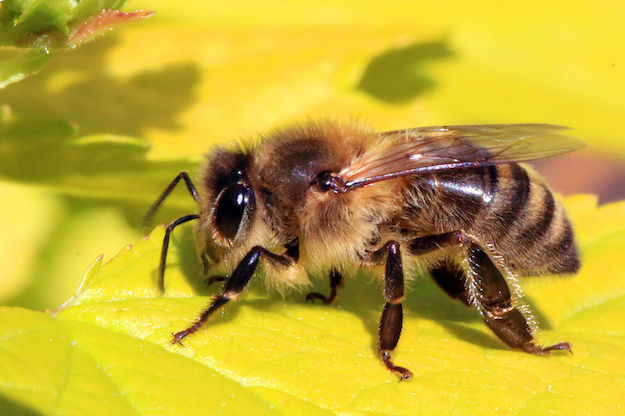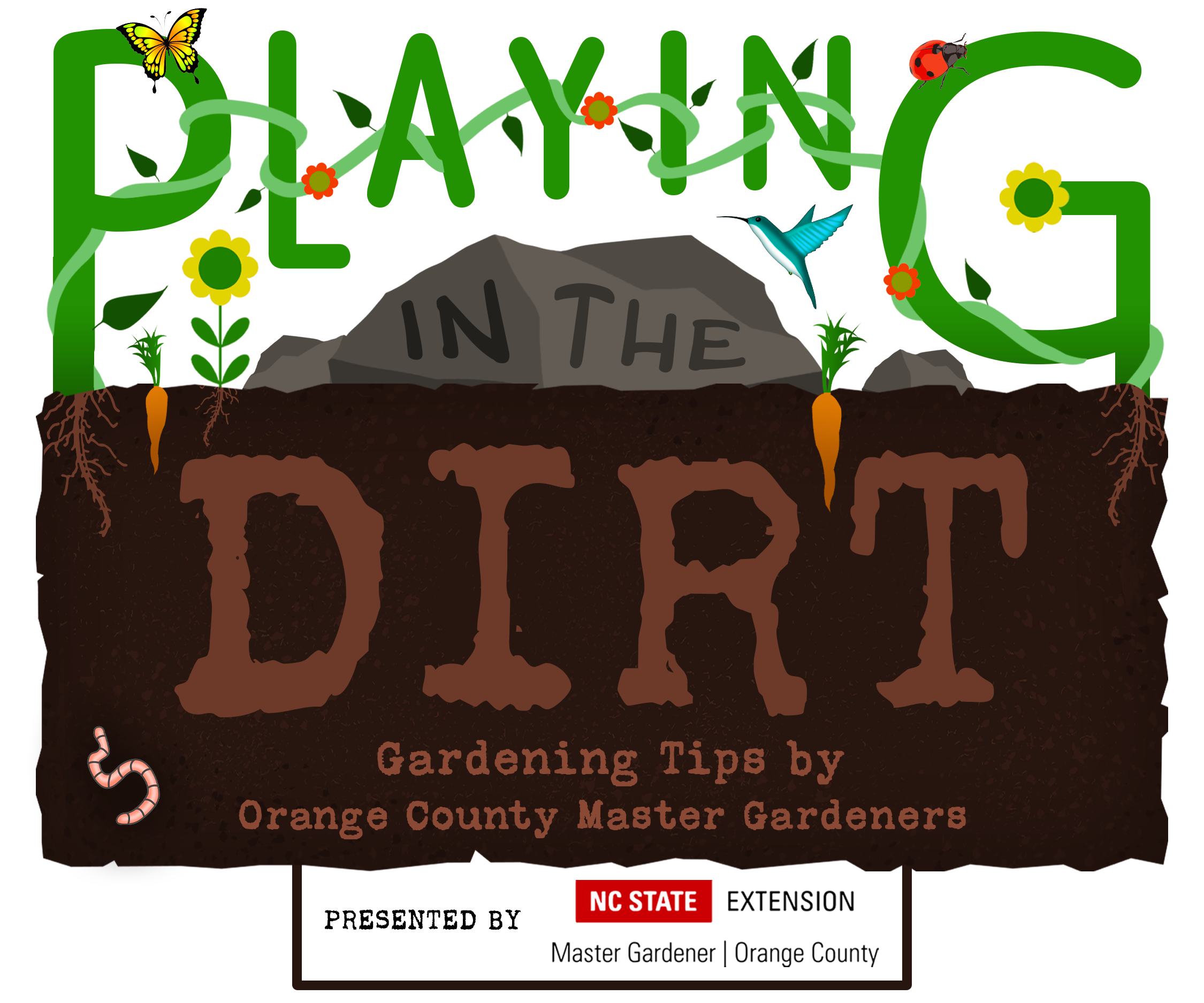
97.9 The Hill and Chapelboro.com have partnered with Orange County Master Gardeners for “Playing in the Dirt,” a monthly column exploring the fertile ground of home gardening in our community and intended to provide the information and inspiration gardeners of all skills levels need to flourish! Check back on Chapelboro each month for a new subject – from our gardens to yours!
By Diantha Pinner, Orange County Master Gardener volunteer
Hard-working honeybees are essential to the production of much of our food. They pollinate many fruits and crops as well as plants such as clover that feed livestock. And honeybees produce honey and beeswax, which have many uses. They also pollinate plants that are food for wildlife.
Because of honeybees’ important work, their decline in recent years — due largely to parasites and diseases — has been a great concern.
There are 20,000 species of bees in the world and 4,000 in North America. Most bee species are solitary and live alone rather than in hives, as honeybees do. Only nine species are true honeybees, and none is native. North American honeybees are actually European honeybees.
Honeybees’ teamwork and other behavior are fascinating.
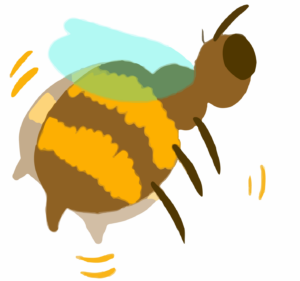
Bee dance. Illustration by Sophie Gabriel.
Communication
Honeybees have a language and communicate through dancing. Their two main dances are the round and the waggle. They forage, come back to the hive and then dance in the direction of the food source they’ve found. The angle of their body in relation to the sun tells other bees the direction of the food source, and the waggle or the round communicates the distance. They use the waggle when the food source is more than 200 yards away, and the round when it is less than 100 yards.
Hearing
Screaming at a bee is not effective. Honeybees can’t hear, but they can feel vibrations.
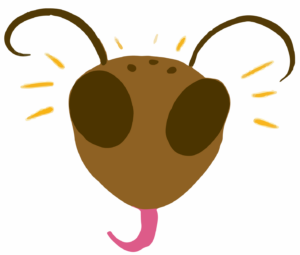
Bee eyes. Illustration by Sophie Gabriel.
Sight
Even though honeybees have five eyes — two compound and three simple — their eyesight is bad. Their eyes can’t move or focus. However, they can detect movement, and the simple eyes (ocelli) help them see light intensity. To navigate, they use their sense of smell instead.
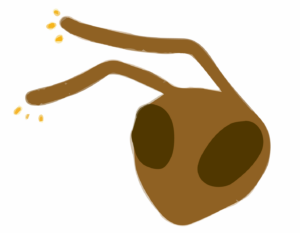
Bees smell with antennae. Illustration by Sophie Gabriel.
Smell
Honeybees’ sense of smell is twice as strong as a dog’s. They don’t have noses and instead use their antennae to smell. They can smell the carbon dioxide and sweat of potential predators; floral odors, including flowers, hairspray, perfume and other scented products; and pheromones.
Roles in the Hive
Any female bee can become a queen. Genetically, they are all the same — it just depends on what they are fed when they are larvae. Female bees that are fed royal jelly become queens. Workers are fed bee bread, which is a digestible version of pollen mixed with nectar or honey. Drones (males) don’t have any role except mating and fertilizing the queen. Sounds cushy, but they are the ones who will get kicked out of the hive if there’s not enough food during winter.
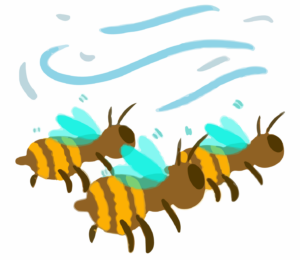
Cooling the hive. Illustration by Sophie Gabriel.
They Like a Comfy Hive
Bees like the inside of the hive to be about 95 degrees. When the hive gets hot in the summer, they all turn to face the same way and flap their wings to create more airflow, thus cooling the hive. When it gets too cold, they insulate the walls with propolis like we do with caulk.

Nurse role. Illustration by Sophie Gabriel.
How Jobs Are Assigned
Their job depends on their age and progresses throughout their lives. Honeybees start out as callow bees, who can’t do anything but get out of their cells. As youths they become nurse bees who feed the queen and brood. Later they start processing honey and pollen and constructing the comb. During the final stage they go out and forage for nectar, pollen, propolis and water. This job is reserved for the oldest because it leaves them more vulnerable and they are more expendable.
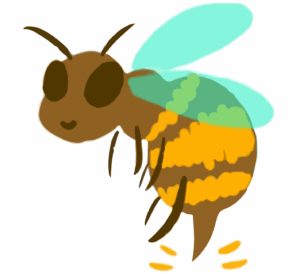
Bee sting. Illustration by Sophie Gabriel.
Why Do Bees Sting?
Honeybees are the only bees that die after stinging and will sting only if they think they are threatened. Wasps will sting just because you’re in their way, because they are omnivores and predators, always on the offense while looking for food. Honeybees, on the other hand, are herbivores — all they care about is making honey. They don’t care about you.
Killer Bees
Africanized (aka killer) honeybees are no different from our bees when it comes to their stingers. They will die when they sting, and the sting contains the same amount of venom. What’s different is their behavior. Africanized honeybees are five times more defensive than European honeybees. As a result, more bees will attack and sting. When one gives off the alarm pheromone, they all come to help defend.
They have spread across the United States quickly because they swarm more. European honeybees focus on collecting enough food to get through the winter. But Africanized honeybees come from the tropics and aren’t used to the cold of our climate. As a result, they keep reproducing and spreading to ensure their survival. But don’t worry — more people die each year from lightning strikes than from killer bees.
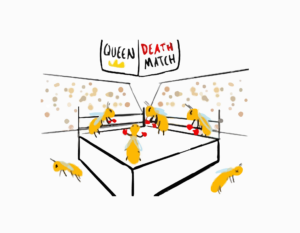
Deciding the queen. Illustration by Sophie Gabriel.
Selection of a Queen
Queens live for one to five years while workers live six weeks and drones only 24 days. When the queen dies, the bees raise multiple larvae to become new queens, who then fight to the death to become the one for the hive. If there’s a tie, one queen leaves the colony to form a new hive, taking some of the bees with her.
Establishing a New Hive
When establishing a hive, the honeybees make a temporary home base while foragers go out to find the best spot for the new hive. They come back and dance, other bees go check out the location, and if they like it, they come back and dance their approval. Ultimately, they all decide on the best location and establish the hive there. Bees have no ego. They only care for what’s best for the hive and colony and they will make the best group decision, exemplifying the perfect democracy.
How You Can Support Honeybees
Honeybees are polylectic — they feed from many different plants. They need both pollen and nectar to stay healthy. Honeybee colonies can survive in winter on stored honey and pollen. Beekeepers also support them in winter. But honeybees’ best nutrition comes from plants. Here’s how you can help:
Plant several blooming species for each season (the plants will also support other pollinators):
Some plants that support honeybees at different seasons include Hellebore, bee balm, sunflower, catmint, purple coneflower, black-eyed Susan, Joe-pye weed, aster and goldenrod. Honeybees also love dandelions, clovers and vetch as well as hollies, blackberries and raspberries.
Honeybees rely on trees for much of their food. Red maples, sugar maples and willows attract honeybees in late winter and early spring, followed by tulip poplars, black gums and black locusts in April and May and persimmons and sourwoods in May and June.
Avoid use of chemical pesticides, herbicides and fertilizers: Chemicals harm bees. If you must spray, don’t spray plants that are in bloom and use the spray in the evening so it dries before bees are active in the morning. Instead of chemical fertilizers, add compost and other organic material to your garden.
Add a bee bath to your yard: Honeybees need water. Set up a shallow container and add pebbles as a landing pad for bees. Add water but leave the tops of the stones showing above the water level (don’t forget to refill the container frequently).
Become a beekeeper: The Orange County Beekeepers Association offers beekeeping classes as well as community education to raise awareness of honeybees.
Additional Resources
- Flowering Plants. Common sources of pollen in North Carolina and bloom dates (scroll to Piedmont Region). North Carolina State Beekeepers Association.
- Honey Plants of North Carolina. Includes a list of plants and bloom dates for our Piedmont region. NC State University Department of Entomology.
- Native Plants for Bees. North Carolina Cooperative Extension, Forsyth County Center.
- The Need for Bees. Clemson Cooperative Extension.
- Contact the Orange County Swarm Patrol to have a honeybee swarm removed safely by members of the Orange County Beekeepers Association.
- How to Help Bees and Butterflies Survive the Winter. University of New Hampshire Extension.
Check Us Out!
Have a plant or garden question? Email the Orange County Master Gardener Volunteers at ocmgardeners@gmail.com or phone 919-245-2061.
Dig Deeper With Us talks, sponsored by the Orange County Master Gardener Volunteers, are at the Orange County Library on the third Saturday of the month, 2 to 3:30 p.m. More information here. We’re skipping December but other talks will include:
- November 19: Everything Tools
- January 21: Winter Sowing
- February 18: Shade Gardening
- March 18: Straw Bale Gardening
Subscribe to The Garden Buzz, the Orange County Master Gardeners’ monthly newsletter, for gardening news and tips. And visit our website, The Orange Gardener.
Chapelboro.com does not charge subscription fees, and you can directly support our efforts in local journalism here. Want more of what you see on Chapelboro? Let us bring free local news and community information to you by signing up for our biweekly newsletter.

